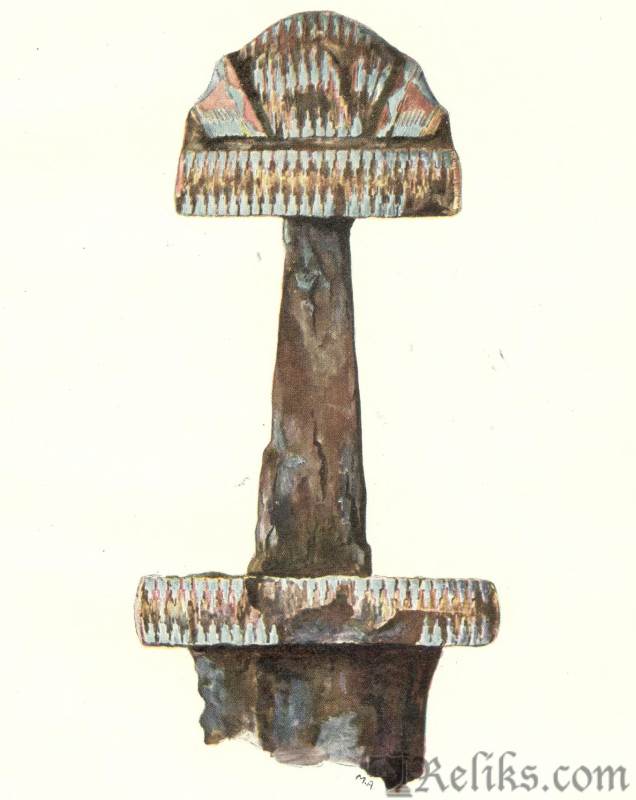Viking Sword Type V (Tripartite Pommel with Stepped Ornament)
Overview
Type V is a relatively rare Viking sword form, known from just six confirmed examples in Norway, all from the western coastal regions. At first glance, its simple tripartite pommel and straight guards may not seem unusual, but the details of its ornamentation — particularly the stepped, ladder-like inlays of bronze or silver — mark it as distinct. This sword type represents a continuity with earlier tripartite pommel traditions (Types D and E) but dates securely to the early 10th century, making it one of the last echoes of those older designs before the more massive S, T, and U types emerged.
Form & Ornament

Viking Sword Type V -Tripartite Pommel
The most recognizable feature of Type V is its pommel, which rises 3–4 cm in height and is divided into three lobes. Unlike the heavily thickened mid-sections of Types R or S, the lobes here are more evenly sized, separated by shallow curves, and together form a smooth, rounded upper line.
Decoration is always present: the hilts are clad in metal overlays of bronze or silver, most often in a stepped or “trappeformet” pattern. One notable sword from Østebø (St 2266, Vikedal, Rogaland) adds twisted silver wire in the grooves between pommel and guard, giving it a richer look. Another from Torblå in Ulvik (B 2799) shows traces of damascened markings on the blade — rare for this type.
Distribution & Finds
So far, Type V is known only from Western Norway — Rogaland, Hordaland, and Romsdal — with no confirmed finds in eastern districts. The six examples Petersen lists are:
- B 4346, Gautetun (Suldal, Rogaland)
- St 2389, Augland (Hæland, Rogaland)
- St 2266, Østebø (Vikedal, Rogaland)
- B 2799, Torblå (Ulvik, Hordaland)
- B 4830, Stamnes (Bruvik, Hordaland)
- B 4347, Prestegården (Skodje, Romsdal)
All are double-edged blades. None carry inscriptions, though corrosion has destroyed much of the surface detail.
Dating Evidence
Several finds provide strong chronological anchors. At Gautetun, the sword was buried with an E-type axe, an I-type spearhead, and oval brooches (R 652) — a combination pointing clearly to the early 10th century. Other graves contained slender, high-ridged spearheads, shield bosses of type R 562, and young oval brooches, all of which confirm a dating before the rise of Types T and U.
The stepped ornament also links Type V to early 10th-century spearheads decorated in the same fashion, strengthening the association.
Wider Connections
Though rare in Norway, Petersen noted clear parallels abroad. Similar swords with stepped bronze inlay occur in Sweden, the Baltic (Ösel), Russia, and East Prussia, suggesting Type V belongs to a shared North European fashion. In some cases, foreign examples even accompany continental imports like Frankish Ulfberht blades, hinting at the cross-currents of trade and warfare that carried weapon styles across the Baltic.
Its restrained form and consistent decoration suggest that, unlike the highly individualized R- and S-types, Type V may have been a more standardized regional style, produced in modest numbers for coastal warriors.
Historical Context
By the early 10th century, the Viking world was shifting from raiding bands toward larger, more organized armies and fleets. Swords like Type V, with their functional blades and modest but consistent ornament, may represent the arms of local magnates and their retainers — practical weapons, but still bearing enough decoration to mark status in life and in burial. Their appearance almost exclusively in western Norway reflects that region’s close connections to the wider North Sea world.
Closing Reflection
Type V swords may not be among the most numerous, but their rarity gives them special weight. With their tripartite pommels and stepped metal ornament, they preserve the memory of older Viking traditions while quietly signaling the transition into the 10th century. These were not flamboyant prestige pieces like the lavish S-types, nor were they the stripped-down U-forms of the century’s end. Instead, they occupy a middle ground: weapons of capable warriors who still valued ornament and symbolism, but whose swords were built for use as much as for display.
The strong concentration of finds in western Norway is telling. This was a region deeply engaged in overseas contact—raiding, trading, and settling across the North Sea—and the stepped motifs on these hilts mirror fashions found as far afield as the Baltic and Russia. In Type V we glimpse how regional blacksmiths adapted continental and Baltic tastes into a distinctly Norwegian form, blending outside influence with local tradition.
For historians and enthusiasts, Type V stands as one of the final echoes of the early Viking pommel styles. Its measured proportions and consistent decoration suggest an effort at standardization, a sign of the changing military culture of the early 900s. As larger armies and fleets reshaped the Viking world, swords like these ensured that more men could be armed—still with weapons of dignity, but without the extravagance reserved for the elite.
In this way, Type V matters because it bridges two worlds: the heroic age of raiding in the 9th century and the more organized, large-scale conflicts of the 10th. Modest, functional, and quietly beautiful, it embodies the steady evolution of the Viking sword as both a weapon of war and a symbol of status.
Core classification based on Jan Petersen, De Norske Vikingesverd (1919). Additional commentary by Reliks.com.